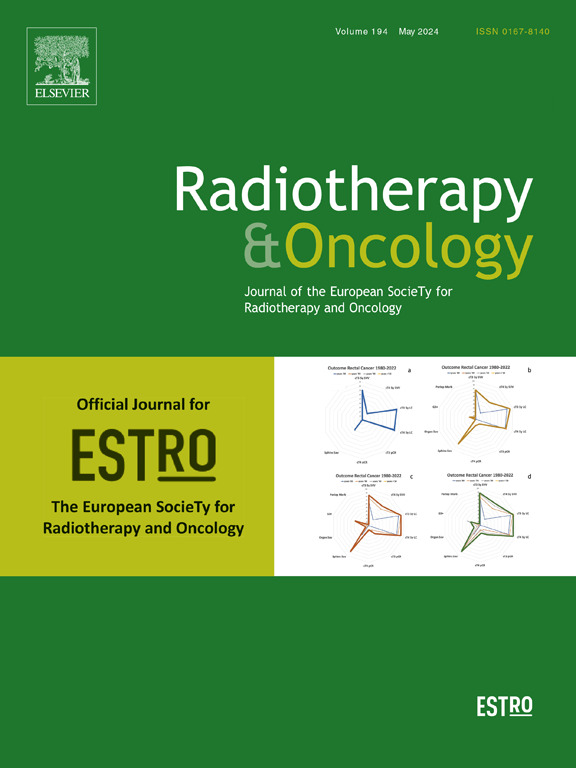Dosimetric advantages of adaptive IMPT vs. Enhanced workload and treatment time – A need for automation
IF 5.3
1区 医学
Q1 ONCOLOGY
引用次数: 0
Abstract
Introduction
In head-and-neck IMPT, trigger-based offline plan adaptation (Offlinetrigger-based) is often used. Our goal was to compare this to four alternative adaptive strategies for dosimetry, workload and treatment time, considering also foreseen further technological advancements, including anticipated automation.
Materials and methods
Alternative strategies included weekly offline re-planning (Offlineweekly), daily plan selection from a library (Librarystatic and Libraryprogsressive) and a fast, approximate daily online re-optimization approach (Onlinere-opt). Impact on CTV coverage and NTCPs was assessed by simulations based on repeat-CTs from 15 patients. Full daily re-planning was used as dosimetric benchmark. Increases in workload and treatment time were estimated.
Results
Both for coverage and NTCPs, fast Onlinere-opt performed as well as full re-planning. Compared to current practice, Onlinere-opt showed enhanced probabilities for high coverage, and resulted in reductions in grade ≥ II NTCPs of 4.6 ± 1.7 %-point for xerostomia and 4.2 ± 2.3 %-point for dysphagia. Offlineweekly and library strategies did not show coverage enhancements and resulted in smaller NTCP improvements. Further automation can largely limit workload and treatment time increases. With anticipated further automation, adaptation-related workload of Offlineweekly, Librarystatic, Libraryprogressive, and Onlinere-opt was expected to increase by 3, 8, 21, and 66 h for 35 fraction treatment courses compared to Offlinetrigger-based. The corresponding adaptation-related prolonged treatment times were estimated to be 0, 4, 6, and 29 min/fraction.
Conclusion
Online adaptive strategies could approach dosimetric quality of full re-planning at the cost of additional workload and prolonged treatment time compared to the current offline adaptive strategy. Automation needs to play a key role in making more complex adaptive approaches feasible.
自适应 IMPT 的剂量学优势与增加工作量和治疗时间的对比--需要自动化。
前言头颈部 IMPT 通常采用基于触发的离线计划适应(Offlinetrigger-based)。我们的目标是将其与剂量测定、工作量和治疗时间方面的四种备选适应策略进行比较,同时考虑到可预见的进一步技术进步,包括预期的自动化:替代策略包括每周离线重新规划(Offlineweekly)、每日从库中选择计划(Librarystatic 和 Libraryprogsressive)以及快速、近似的每日在线重新优化方法(Onlinere-opt)。根据 15 名患者的重复 CT 进行模拟,评估了对 CTV 覆盖率和 NTCP 的影响。全日重新规划被用作剂量基准。结果:结果:在覆盖率和NTCPs方面,快速Onlinere-opt的表现与全面重新规划不相上下。与目前的做法相比,Onlinere-opt 显示出更高的高覆盖率,并使口腔异物感和吞咽困难的≥II 级 NTCP 分别降低了 4.6 ± 1.7% 点和 4.2 ± 2.3% 点。离线每周策略和图书馆策略没有显示出覆盖率的提高,NTCP 的改善幅度也较小。进一步自动化可在很大程度上限制工作量和治疗时间的增加。在预期进一步自动化的情况下,与基于离线触发的治疗相比,离线每周、Librarystatic、Libraryprogressive 和 Onlinere-opt 的适应性相关工作量预计在 35 个分数治疗疗程中分别增加 3、8、21 和 66 小时。相应的适应性延长治疗时间估计为0、4、6和29分钟/分次:与目前的离线自适应策略相比,在线自适应策略可以接近完全重新规划的剂量学质量,但代价是额外的工作量和治疗时间的延长。要使更复杂的自适应方法变得可行,自动化需要发挥关键作用。
本文章由计算机程序翻译,如有差异,请以英文原文为准。
求助全文
约1分钟内获得全文
求助全文
来源期刊

Radiotherapy and Oncology
医学-核医学
CiteScore
10.30
自引率
10.50%
发文量
2445
审稿时长
45 days
期刊介绍:
Radiotherapy and Oncology publishes papers describing original research as well as review articles. It covers areas of interest relating to radiation oncology. This includes: clinical radiotherapy, combined modality treatment, translational studies, epidemiological outcomes, imaging, dosimetry, and radiation therapy planning, experimental work in radiobiology, chemobiology, hyperthermia and tumour biology, as well as data science in radiation oncology and physics aspects relevant to oncology.Papers on more general aspects of interest to the radiation oncologist including chemotherapy, surgery and immunology are also published.
 求助内容:
求助内容: 应助结果提醒方式:
应助结果提醒方式:


